Workplace Bullying in Healthcare Organizations of New Zealand
Added on 2023-05-27
62 Pages15429 Words476 Views
Running head: MANAGEMENT
Management
Name of the Student
Name of the University
Author Note
Management
Name of the Student
Name of the University
Author Note
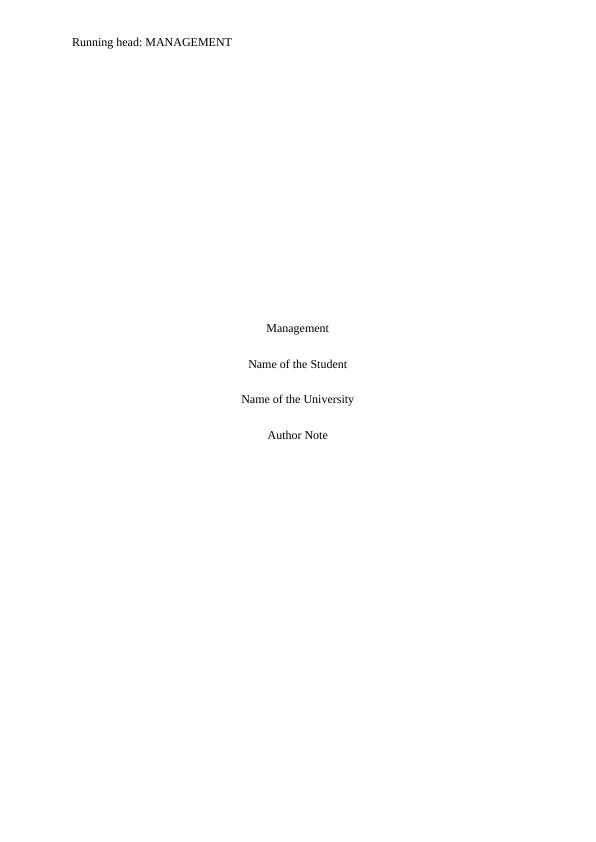
1MANAGEMENT
Abstract
This study is mainly based on workplace harassment in New Zealand’s healthcare
organization. The aim of this research is to analyse the consequences of workplace bullying
and different solution should be addressed in order to avoid such illegal and unethical
activities in workplace. In the review of literature, it is mentioned that workplace bullying can
lead to serious health issue such as depression and other major health problems. Workplace
bullying can give rise to interpersonal conflicts, whereas a small amount of conflict is healthy
in an organization but if it exceeds a certain limit it can hamper the employee’s work
efficiency as well as decreases the productivity of an organization. The primary data collected
by interviewing 50 respondents of the healthcare organization in New Zealand, has been
analysed by means of graphs and charts. From different articles and journals secondary data
has been collected. Sampling method used during primary data collection is non-profitability
sampling method. Findings signifies that workplace bullying is common in healthcare
organization and most of the employee have experienced such incident, but they remain silent
by the fear of getting terminated. Large organization are usually dominated by senior
authorities and hence they are the ones who are mostly involved in such cases. In many cases
workplace harassment can lead to large number of employee turnover. To lower the number
of employee turnover, necessary steps should be taken by the department of human resource
and everyone in the organization should be aware of the consequences of such unethical
activities.
Abstract
This study is mainly based on workplace harassment in New Zealand’s healthcare
organization. The aim of this research is to analyse the consequences of workplace bullying
and different solution should be addressed in order to avoid such illegal and unethical
activities in workplace. In the review of literature, it is mentioned that workplace bullying can
lead to serious health issue such as depression and other major health problems. Workplace
bullying can give rise to interpersonal conflicts, whereas a small amount of conflict is healthy
in an organization but if it exceeds a certain limit it can hamper the employee’s work
efficiency as well as decreases the productivity of an organization. The primary data collected
by interviewing 50 respondents of the healthcare organization in New Zealand, has been
analysed by means of graphs and charts. From different articles and journals secondary data
has been collected. Sampling method used during primary data collection is non-profitability
sampling method. Findings signifies that workplace bullying is common in healthcare
organization and most of the employee have experienced such incident, but they remain silent
by the fear of getting terminated. Large organization are usually dominated by senior
authorities and hence they are the ones who are mostly involved in such cases. In many cases
workplace harassment can lead to large number of employee turnover. To lower the number
of employee turnover, necessary steps should be taken by the department of human resource
and everyone in the organization should be aware of the consequences of such unethical
activities.
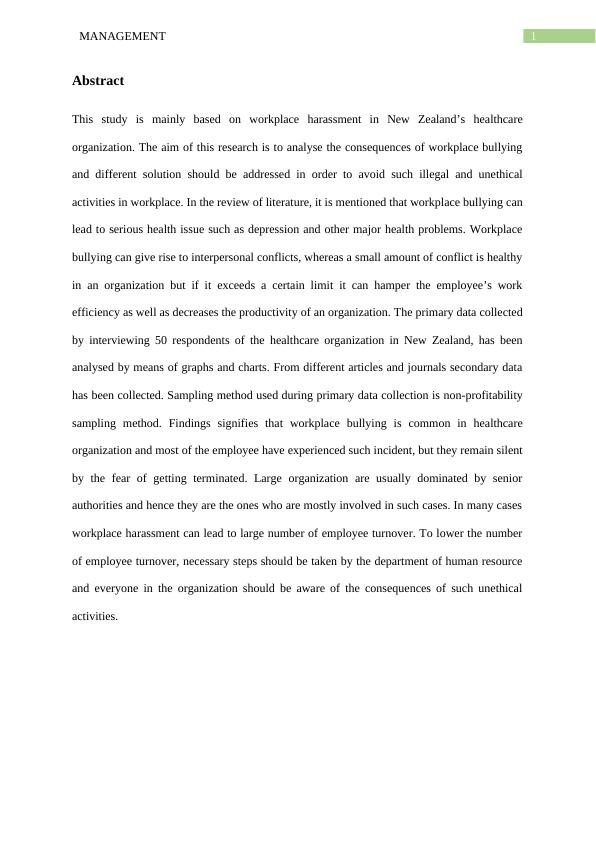
2MANAGEMENT
Table of Content
CHAPTER 1: INTRODUCTION..............................................................................................6
1.1 Introduction......................................................................................................................6
1.2 Outline of the Study.........................................................................................................6
1.3 Scope of Investigation......................................................................................................8
1.4 Problem Statement...........................................................................................................8
1.5 Aim of the Research and Objectives................................................................................8
1.6 Research Questions..........................................................................................................9
1.7 Research Rationale/Importance.......................................................................................9
1.8 Research Outline............................................................................................................10
1.9 Research Limitation.......................................................................................................10
CHAPTER 2: LITERATURE REVIEW.............................................................................11
2.1 Introduction..................................................................................................................11
2.2 Workplace bullying in healthcare sector...................................................................11
2.3 Impact of Workplace Bullying....................................................................................13
2.4 Bullying prevalence in the context of New Zealand..................................................16
2.5 Regulatory impact of workplace bullying..................................................................17
2.6 Factors contributing to Workplace Bullying.............................................................19
2.7 Actions that can be applied to prevent workplace bullying.....................................22
2.8 Gaps in the Literature.................................................................................................24
CHAPTER 3: RESEARCH METHODOLOY........................................................................26
3.1 Introduction....................................................................................................................26
Table of Content
CHAPTER 1: INTRODUCTION..............................................................................................6
1.1 Introduction......................................................................................................................6
1.2 Outline of the Study.........................................................................................................6
1.3 Scope of Investigation......................................................................................................8
1.4 Problem Statement...........................................................................................................8
1.5 Aim of the Research and Objectives................................................................................8
1.6 Research Questions..........................................................................................................9
1.7 Research Rationale/Importance.......................................................................................9
1.8 Research Outline............................................................................................................10
1.9 Research Limitation.......................................................................................................10
CHAPTER 2: LITERATURE REVIEW.............................................................................11
2.1 Introduction..................................................................................................................11
2.2 Workplace bullying in healthcare sector...................................................................11
2.3 Impact of Workplace Bullying....................................................................................13
2.4 Bullying prevalence in the context of New Zealand..................................................16
2.5 Regulatory impact of workplace bullying..................................................................17
2.6 Factors contributing to Workplace Bullying.............................................................19
2.7 Actions that can be applied to prevent workplace bullying.....................................22
2.8 Gaps in the Literature.................................................................................................24
CHAPTER 3: RESEARCH METHODOLOY........................................................................26
3.1 Introduction....................................................................................................................26
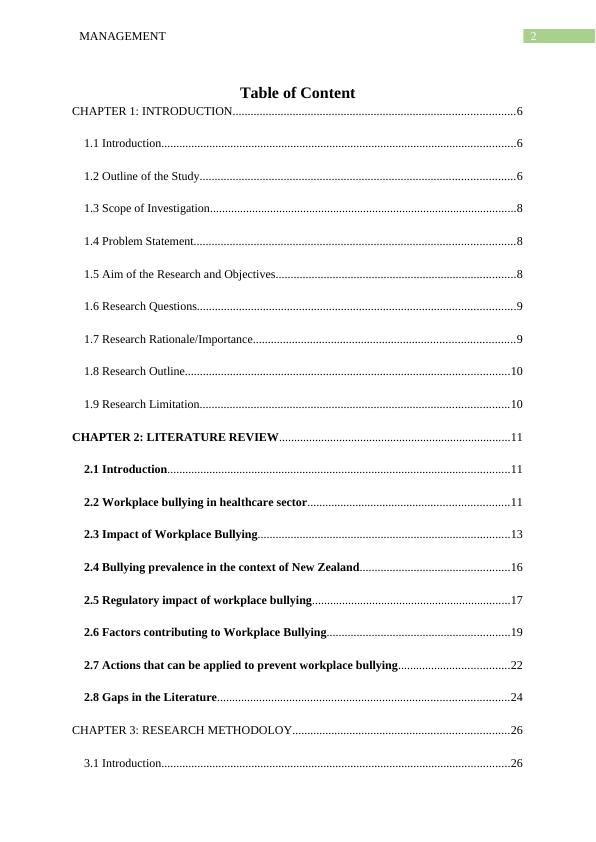
3MANAGEMENT
3.2 Research Philosophy......................................................................................................26
3.3 Research Approach........................................................................................................27
3.4 Research Design.............................................................................................................28
3.5 Data Collection...............................................................................................................29
3.6 Sampling........................................................................................................................30
3.7 Ethical Consideration.....................................................................................................31
3.8 Research Limitations and Assumptions.........................................................................32
3.9 Conclusion......................................................................................................................33
CHAPTER 4: FINDINGS AND ANALYSIS.........................................................................34
4.1 Introduction....................................................................................................................34
4.2 Measureable data (Review of the data)..........................................................................34
Chapter 5: Conclusion and Recommendation..........................................................................52
5.1 Conclusion......................................................................................................................52
References................................................................................................................................53
3.2 Research Philosophy......................................................................................................26
3.3 Research Approach........................................................................................................27
3.4 Research Design.............................................................................................................28
3.5 Data Collection...............................................................................................................29
3.6 Sampling........................................................................................................................30
3.7 Ethical Consideration.....................................................................................................31
3.8 Research Limitations and Assumptions.........................................................................32
3.9 Conclusion......................................................................................................................33
CHAPTER 4: FINDINGS AND ANALYSIS.........................................................................34
4.1 Introduction....................................................................................................................34
4.2 Measureable data (Review of the data)..........................................................................34
Chapter 5: Conclusion and Recommendation..........................................................................52
5.1 Conclusion......................................................................................................................52
References................................................................................................................................53
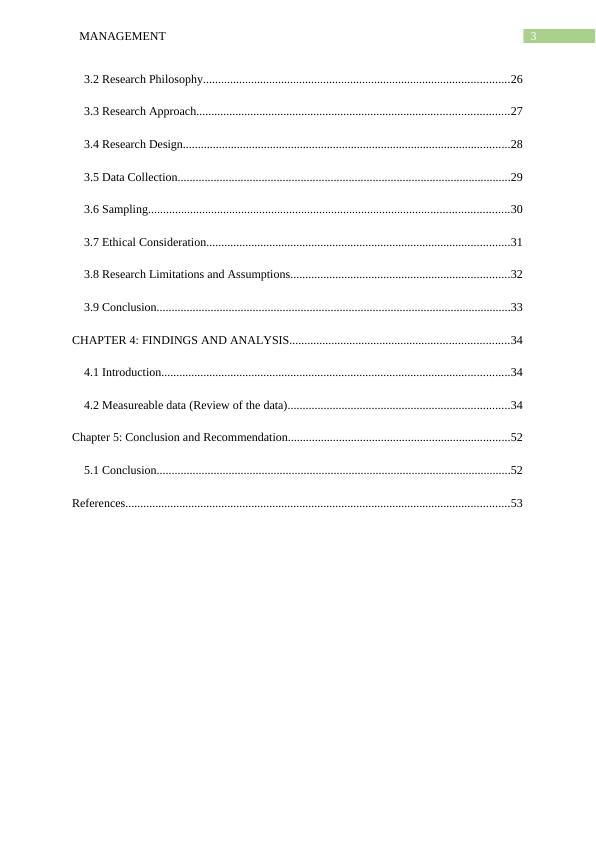
4MANAGEMENT
List of Graph
Graph 1: Respondents’ gender.................................................................................................32
Graph 2: Age Criteria of employees........................................................................................33
Graph 3: Employee Tenure in the organization.......................................................................34
Graph 4: Scope for full time equivalent four day working environment.................................35
Graph 5: Whether employees have experienced exploitation in the workplace......................36
Graph 6: Experience of bullying in the workplace..................................................................37
Graph 7: Employees’ own initiative against workplace bullying............................................39
Graph 8: Necessity of Grievance department in the organization...........................................40
Graph 9: Necessity of Human Resource department to resolve workplace bullying..............41
Graph 10: Workplace bullying mentally harass individuals....................................................43
Graph 11: Whether workplace bullying lead to employee turnover........................................44
Graph 12: Importance of communication in resolving employees issues in the workplace....46
Graph 14: Whether workplace should be legally addressed instead of keeping it within the
agency......................................................................................................................................47
Graph 14: The need of legal framework in the organization...................................................48
List of Graph
Graph 1: Respondents’ gender.................................................................................................32
Graph 2: Age Criteria of employees........................................................................................33
Graph 3: Employee Tenure in the organization.......................................................................34
Graph 4: Scope for full time equivalent four day working environment.................................35
Graph 5: Whether employees have experienced exploitation in the workplace......................36
Graph 6: Experience of bullying in the workplace..................................................................37
Graph 7: Employees’ own initiative against workplace bullying............................................39
Graph 8: Necessity of Grievance department in the organization...........................................40
Graph 9: Necessity of Human Resource department to resolve workplace bullying..............41
Graph 10: Workplace bullying mentally harass individuals....................................................43
Graph 11: Whether workplace bullying lead to employee turnover........................................44
Graph 12: Importance of communication in resolving employees issues in the workplace....46
Graph 14: Whether workplace should be legally addressed instead of keeping it within the
agency......................................................................................................................................47
Graph 14: The need of legal framework in the organization...................................................48

5MANAGEMENT
List of Tables
Table 1: Respondents’ gender..................................................................................................31
Table 2: Age Criteria of employees.........................................................................................32
Table 3: Employee Tenure in the organization........................................................................33
Table 4: Scope for full time equivalent four day working environment..................................34
Table 5: Whether employees have experienced exploitation in the workplace.......................36
Table 6: Experience of bullying in the workplace...................................................................37
Table 7: Employees’ own initiative against workplace bullying.............................................38
Table 8: Necessity of Grievance department in the organization............................................40
Table 9: Necessity of Human Resource department to resolve workplace bullying...............41
Table 10: Workplace bullying mentally harass individuals.....................................................43
Table 11: Whether workplace bullying lead to employee turnover.........................................44
Table 12: Importance of communication in resolving employees issues in the workplace.....46
Table 13: Whether workplace should be legally addressed instead of keeping it within the
agency......................................................................................................................................47
Table 14: The need of legal framework in the organization....................................................47
List of Tables
Table 1: Respondents’ gender..................................................................................................31
Table 2: Age Criteria of employees.........................................................................................32
Table 3: Employee Tenure in the organization........................................................................33
Table 4: Scope for full time equivalent four day working environment..................................34
Table 5: Whether employees have experienced exploitation in the workplace.......................36
Table 6: Experience of bullying in the workplace...................................................................37
Table 7: Employees’ own initiative against workplace bullying.............................................38
Table 8: Necessity of Grievance department in the organization............................................40
Table 9: Necessity of Human Resource department to resolve workplace bullying...............41
Table 10: Workplace bullying mentally harass individuals.....................................................43
Table 11: Whether workplace bullying lead to employee turnover.........................................44
Table 12: Importance of communication in resolving employees issues in the workplace.....46
Table 13: Whether workplace should be legally addressed instead of keeping it within the
agency......................................................................................................................................47
Table 14: The need of legal framework in the organization....................................................47

6MANAGEMENT
Topic: Workplace Bullying in Healthcare Organizations of New Zealand
CHAPTER 1: INTRODUCTION
1.1 Introduction
This research project deals with bullying at workplace taking place in healthcare
organisations all over New Zealand. The main purpose of this report is to determine the
harshness of workplace bullying and extract solutions to reduce the same in healthcare
organisations in New Zealand. It has been cited that workplace bullying is very common
among organisations of every kind. Specifically, in healthcare organisation where people visit
for medical treatment, or where doctors provide prescribed care to people are subjected to
number of occurrence where they have faced or witnessed the harshness of workplace
bullying. This research chapter of this particular dissertation deals and discusses about the
significance of workplace bullying in this particular working organisation of healthcare. This
chapter also features the aims and objectives on which the entire study is revolving on and
how the research work is putting to flight. This chapter ends with subject to a set of
disadvantages based on the study.
1.2 Outline of the Study
Bullying at workplace continues to play an important role since the ancient ages of
corporation, and discontinuing the same is a challenge which comes along the way of every
organisation. It has been mentioned by Branch, Ramsay, and Barker (2013) that notably in
the United States, the workplace bullying institute projects that around 65.6 million
employees are subjected to workplace bullying or have witnessed the same. In 2014 a survey
was done by the workplace bullying institute resulting to which they found out that nearly
69% of the cases of bullies targeted are men whereas 57% of the population of victims
constitute women in a particular organisation in an average, which comes to the point that
Topic: Workplace Bullying in Healthcare Organizations of New Zealand
CHAPTER 1: INTRODUCTION
1.1 Introduction
This research project deals with bullying at workplace taking place in healthcare
organisations all over New Zealand. The main purpose of this report is to determine the
harshness of workplace bullying and extract solutions to reduce the same in healthcare
organisations in New Zealand. It has been cited that workplace bullying is very common
among organisations of every kind. Specifically, in healthcare organisation where people visit
for medical treatment, or where doctors provide prescribed care to people are subjected to
number of occurrence where they have faced or witnessed the harshness of workplace
bullying. This research chapter of this particular dissertation deals and discusses about the
significance of workplace bullying in this particular working organisation of healthcare. This
chapter also features the aims and objectives on which the entire study is revolving on and
how the research work is putting to flight. This chapter ends with subject to a set of
disadvantages based on the study.
1.2 Outline of the Study
Bullying at workplace continues to play an important role since the ancient ages of
corporation, and discontinuing the same is a challenge which comes along the way of every
organisation. It has been mentioned by Branch, Ramsay, and Barker (2013) that notably in
the United States, the workplace bullying institute projects that around 65.6 million
employees are subjected to workplace bullying or have witnessed the same. In 2014 a survey
was done by the workplace bullying institute resulting to which they found out that nearly
69% of the cases of bullies targeted are men whereas 57% of the population of victims
constitute women in a particular organisation in an average, which comes to the point that
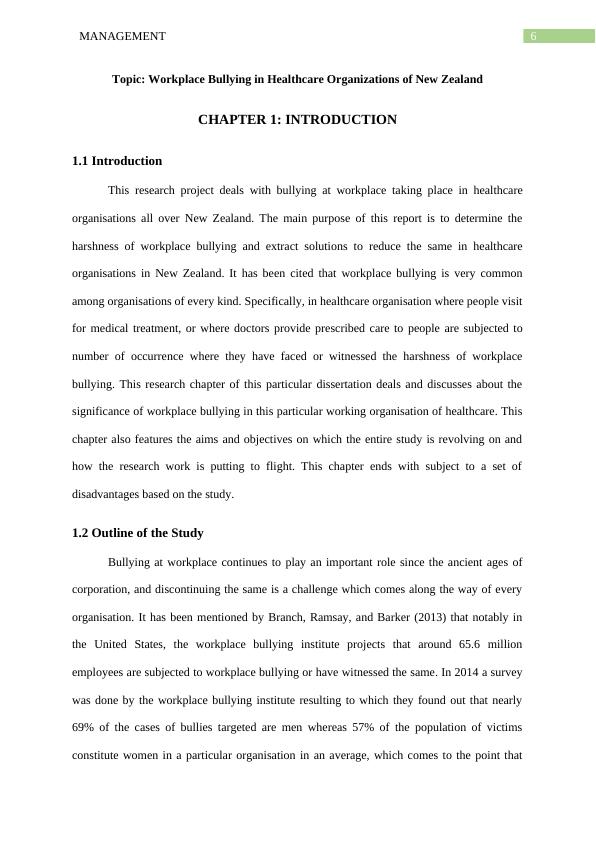
7MANAGEMENT
68% of the bullying cases are targeted towards women (Bjørkelo, 2013). This type of cases
are very usual than the heionous ones like sexual harassment in workplace. These are often
considered as direct physical or even verbal and indirect bullying. In the year 2013 Samnani
stated that bullying typically is intentional and deliberate, at the same time it holds an
important role in imposing an impact which is considered to be extremely negative on the
victim or could be an exertion in controlling workers in the organisation. With increasing
number of study and analysis, it has been established that bullying in itself is an aggressive
behaviour which is usually done intentionally and can be in regular interval too. It has also
been established that in most of the cases bullies target those employees who have or show
inadequate support in the workplace and those, who are not able to defend from those bullies
aggressive behaviour. The crucial form of bullying is that it is anticipated as hostile by the
victim.
In 2016 Bryman produced an example of bullying where it is noted that a manager in
a certain organisation is never satisfied with the performance, the blabbering or spreading
hoax and rumours and purposely dislodging an employee from the team meeting and saying
someone that he or she is too thin skinned person or being continuously summoned to
meetings with the manager which were not planed previously. Correspondingly many events
like this take place in the healthcare industry. Conferring to Cummings and Rowe (2015), in
organisations of healthcare, 44% of the total employees engaged in the activity of nursing
have faced bully and they have also stated that nurse bullying is a part and parcel of their
jobs. In 2018 Dimas mentioned that there are few factors that are fundamental, donate to such
problems which may contain an environment that grants intimidation, low levels of staffing
and increasing work pressure as well as lack of managerial skills. Moreover, on enquiring the
cases, it has been studied that healthcare organisation where intimidation is at pace,
constitutes emergency wards, units of behavioural health and even the intensive care units.
68% of the bullying cases are targeted towards women (Bjørkelo, 2013). This type of cases
are very usual than the heionous ones like sexual harassment in workplace. These are often
considered as direct physical or even verbal and indirect bullying. In the year 2013 Samnani
stated that bullying typically is intentional and deliberate, at the same time it holds an
important role in imposing an impact which is considered to be extremely negative on the
victim or could be an exertion in controlling workers in the organisation. With increasing
number of study and analysis, it has been established that bullying in itself is an aggressive
behaviour which is usually done intentionally and can be in regular interval too. It has also
been established that in most of the cases bullies target those employees who have or show
inadequate support in the workplace and those, who are not able to defend from those bullies
aggressive behaviour. The crucial form of bullying is that it is anticipated as hostile by the
victim.
In 2016 Bryman produced an example of bullying where it is noted that a manager in
a certain organisation is never satisfied with the performance, the blabbering or spreading
hoax and rumours and purposely dislodging an employee from the team meeting and saying
someone that he or she is too thin skinned person or being continuously summoned to
meetings with the manager which were not planed previously. Correspondingly many events
like this take place in the healthcare industry. Conferring to Cummings and Rowe (2015), in
organisations of healthcare, 44% of the total employees engaged in the activity of nursing
have faced bully and they have also stated that nurse bullying is a part and parcel of their
jobs. In 2018 Dimas mentioned that there are few factors that are fundamental, donate to such
problems which may contain an environment that grants intimidation, low levels of staffing
and increasing work pressure as well as lack of managerial skills. Moreover, on enquiring the
cases, it has been studied that healthcare organisation where intimidation is at pace,
constitutes emergency wards, units of behavioural health and even the intensive care units.

End of preview
Want to access all the pages? Upload your documents or become a member.
Related Documents
Cause effects and impacts of high turnover in transport and logistics companieslg...
|51
|14943
|72
Impact of Sustainable Human Resource Management in Hotelslg...
|62
|14588
|147
Developing an Effective Talent Management System for Managers at Bank of the Bahamaslg...
|85
|19988
|484
Impact on Employee Retention PDFlg...
|98
|18225
|53
MANAGEMENT. Management Name of the Student Name of thelg...
|62
|13304
|353
Impact of Leadership style on Employee Performance: A case study of HSBClg...
|87
|19011
|452
